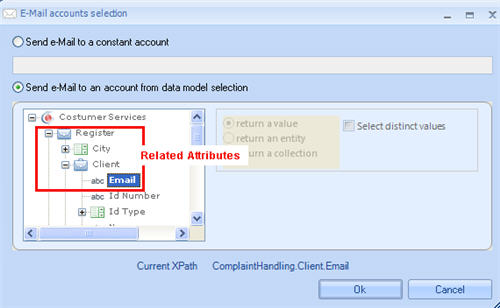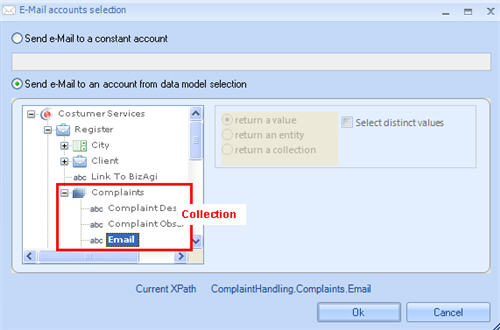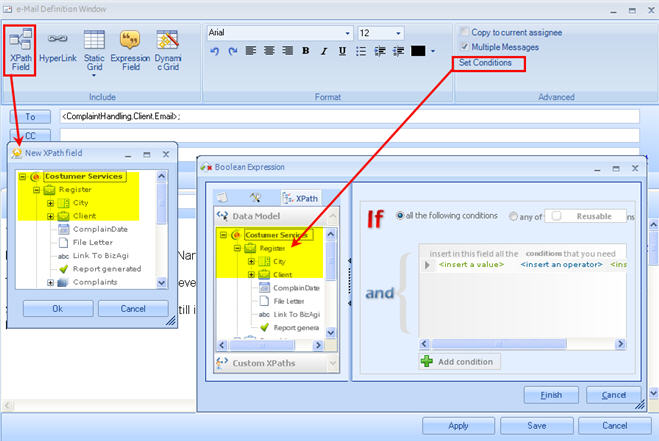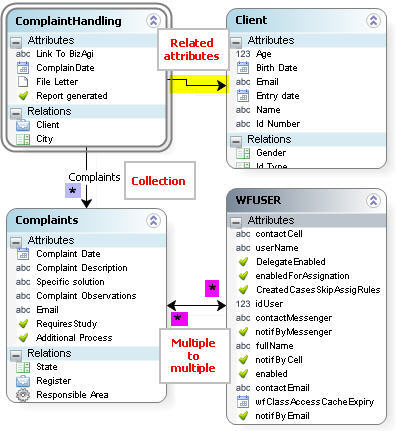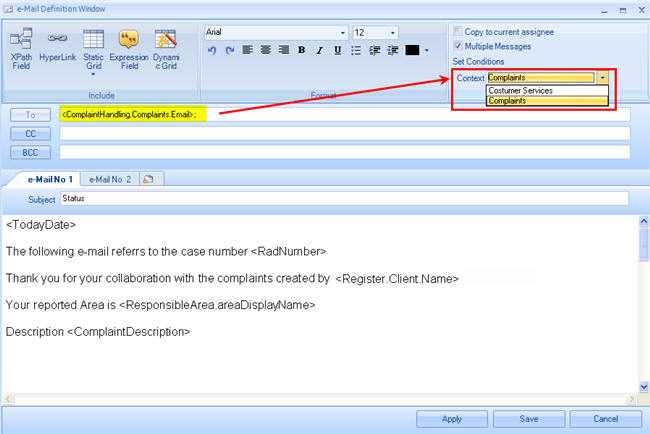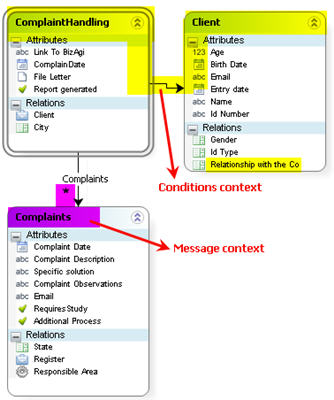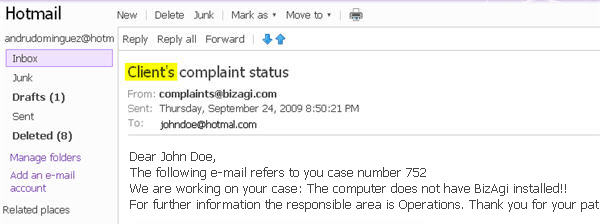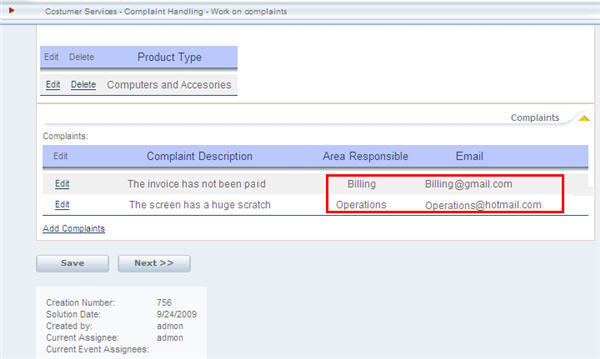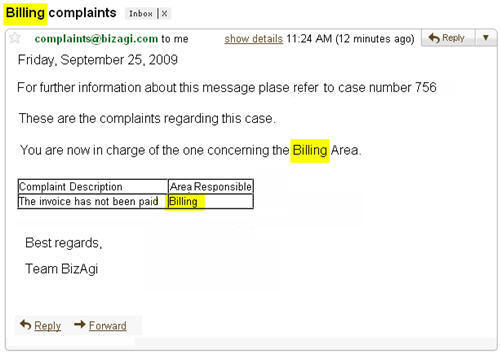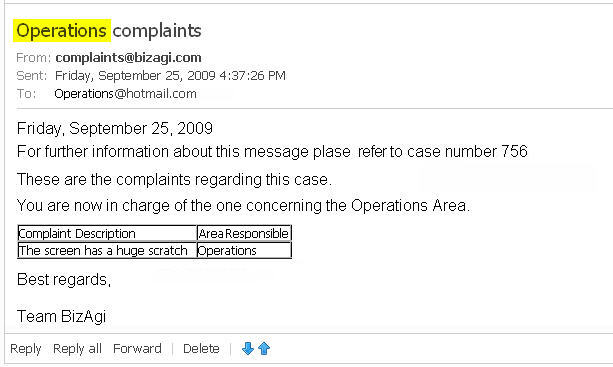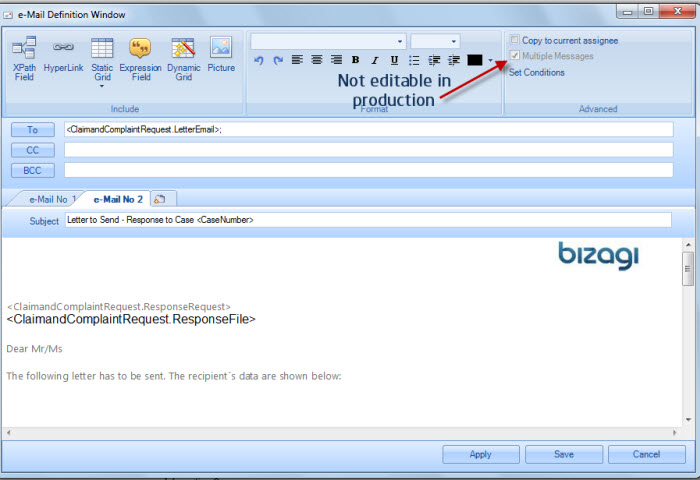Advanced E-Mail Features
From Business Process Management, BPM and Workflow Automation Wiki | BizAgi BPMS
<keywords content="keywords"> e-mail context, contexts, e-mail filter, filters </keywords>
Contents |
Advanced e-mail Features
Multiple messages and contexts
The To field can contain addresses that can be accessed in two different ways: Either they are Related Attributes or they belong to a collection.
When the addresses are obtained through Related Attributes, the typed message and the Conditions of Multiple Messages will all have the same Context. That is, the data will be accessed in the same way, starting from the Main Business Entity.
However, when the addresses in the To field belong to a collection, the Context of the message and the Context of the conditions can be chosen.
Consider the next data model that belongs to a Complaint Handling process:
The main Process Entity is ComplaintHandling. Each case registered can have several Complaints but only one client. Once the complaints have been studied, each of them will belong to one or more Users Responsible. Each user can be responsible for more than one Complaint.
There is a related attributes relationship between ComplaintHandling and Client. There is a collection of Complaints (one-to-many relationship between Register and Complaints) and a multiple-to-multiple relationship between Complaints and Users Responsible.
Suppose the message is sent to all the e-mails that have been typed for each Complaint. In this case, the To context is Complaints because the addresses are chosen from that entity.
Then, the typed message and the conditions can have two contexts: the Main Business Entity (ComplaintHandling) or the many entity (Complaints.)
To choose the contexts, a drop-down list will be shown. It will be shown in the upper right-hand corner for the typed message. For the conditions, it will be shown at the bottom of the condition’s window.
Using contexts
Using the same data model as before, a message will be sent to all the e-mails that have been typed for each of the Complaints.
There will be two different messages depending on the relationship of the creator with the company, either when the person is a client or a supplier.
The information in the message will be associated to each of the complaints. Thus, the context of the message will be Complaints and the context of the conditions will be the Main Business Entity (ComplaintHandling).
This is how the e-mails will look:
Example using conditions to filter
Conditions in messages can also be used to filter a collection. In the previous example, conditions were used to decide when to send the message. In this example conditions will be used to decide which records of the collections fulfill them, and then send an e-mail.
Referring to the same data model as before, one case can have many Complaints. Each Complaint belongs to an Area Responsible. In this case a different e-mail will be sent depending on the area responsible. Notice that in the previous example there where two different cases that received different e-mails according to the client type of each one. In this example a single case will send several e-mails depending on how many complaints there are, and the Area Responsible to which those complaints belong.
Since a case can have many complaints belonging to one Area Responsible, the template context will be the Main Business Entity. This way the user will be able to display all the complaints. The condition will evaluate each complaint, so the context of the conditions will be Complaints.
The following case will deliver the e-mail messages shown below.
<videoflash>OEvxcN9o5v4|640|505|</videoflash>
Multiple Messages in Production
When a project has been deployed, some elements like Notifications will remain editable in the development environment. However to avoid possible problems with subsequent deployments Bizagi restricts changes on some these elements. For this reason, when a Notification with multiple messages is already in production it will not be possible to delete them or change their conditions. Everything else will remain editable (the To field, the template).
<comments />
